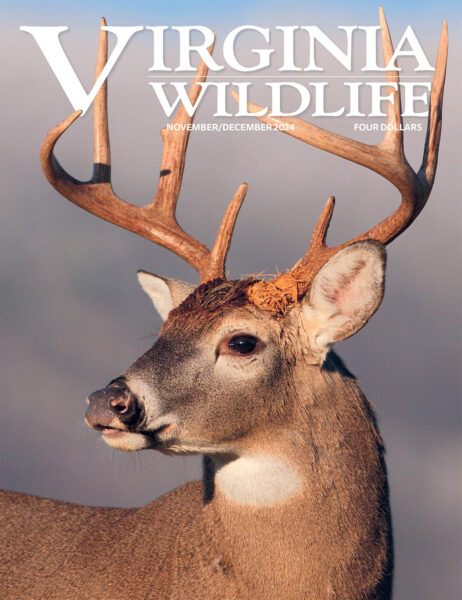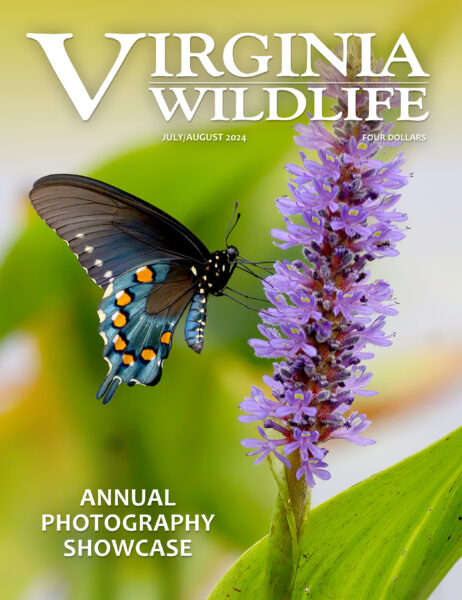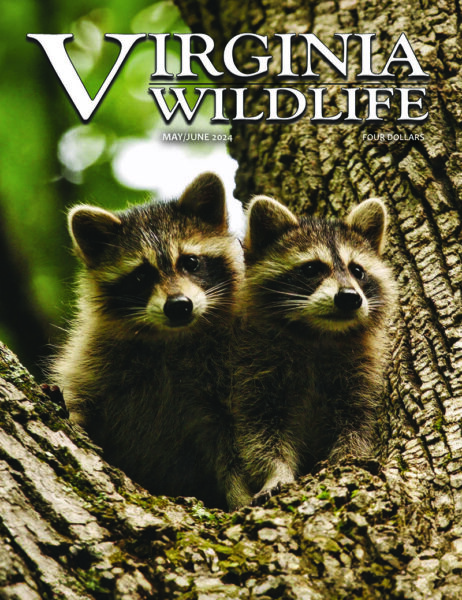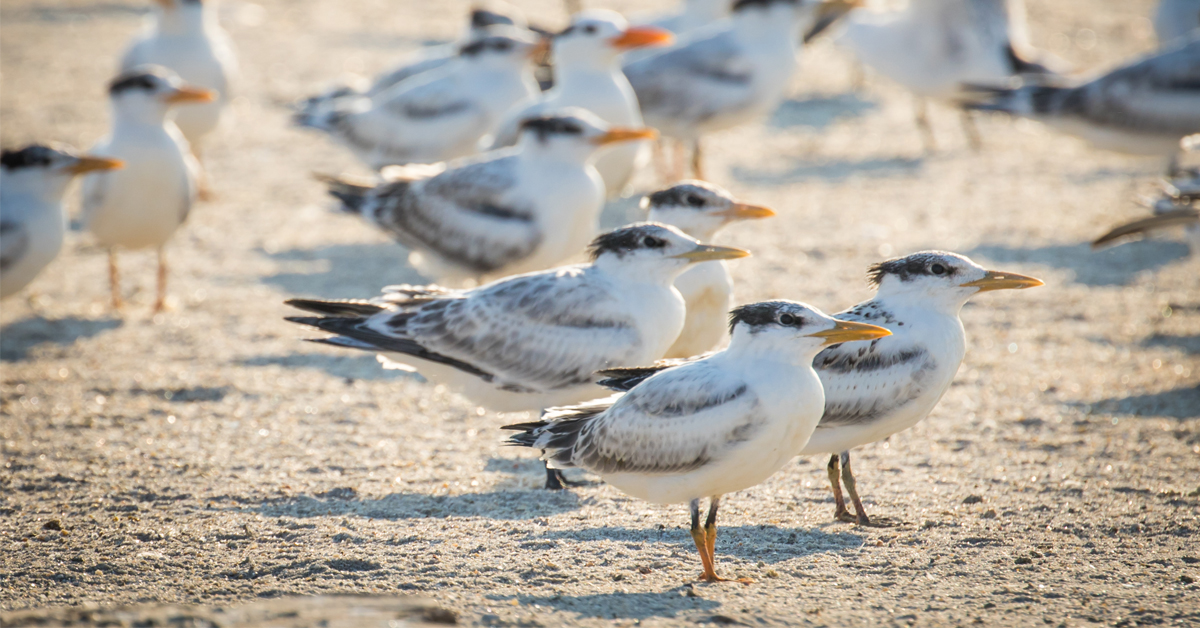
Photo by Meagan Thomas/DWR
By Molly Kirk
How DWR relocated Virginia’s largest seabird colony on a tight timeline.
Ruth Boettcher throttled back on the boat as she approached Rip Raps Island at the mouth of the James River, near Hampton, Virginia, on an early June day. She smiled as she saw hundreds of seabirds swirling in the sky around the fortifications of Fort Wool on the island. Walking onto the island, she gingerly skirted around the thousands of ground nests and scrambled up one of the casements to get a better view of the colony. A few weeks later, the eggs hatched, the chicks learned to fly, and then eventually the entire colony of nearly 20,000 birds departed and embarked on an age-old and sometimes circuitous migratory journey to their southern wintering grounds.
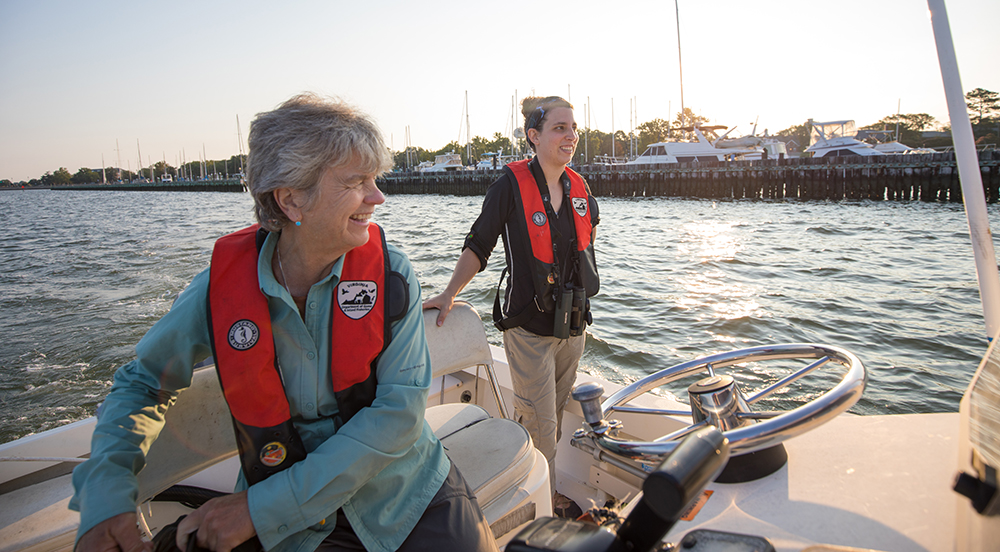
DWR Biologists Ruth Boettcher and Meagan Thomas approach Rip Raps Island to check on the seaboard nesting relocation project. Right: Some of the species of birds found nesting on the barges and Fort Wool. Photo by Meghan Marchetti/DWR
It’s a rhythm of life cycle that’s happened in the Hampton Roads area every year for decades, so the 2020 nesting season might seem unremarkable. But the simple fact that this colony of birds was able to successfully nest, hatch, and fledge in the summer of 2020 was the result of a massively successful conservation effort by representatives of the Virginia Department of Wildlife Resources (DWR) led by Becky Gwynn, assistant chief of DWR’s Wildlife Division; Ruth Boettcher, coastal terrestrial biologist; David Norris, Region 1 wildlife manager; and Stephen Living, Region 1 lands and access manager.
“We only had 90 days to transform the area to the kind of place the birds needed and expected to find on their return to the region,” said Gwynn. “That we did it—and that nearly 20,000 birds used the new habitat—exceeded our wildest expectations! Agencies and organizations across the country are looking at our work as new tools in the conservation toolbox.”
New Home Needed
In the spring, thousands of seabirds migrate to Virginia nesting grounds. The seabirds nest in multiple locations throughout the state’s coastal plain, but South Island, one of two artificial islands that anchor the underwater tunnels of the Hampton Roads Bridge-Tunnel (HRBT) complex at the mouth of the James River, has been home to one of Virginia’s most well established seabird colonies for decades. Unfortunately, when the birds arrived at the island in 2020 they discovered it was completely paved over and therefore unsuitable for nesting.
Each spring, thousands of seabirds would descend upon South Island, within a stone’s throw of the busy interstate highway leading into and out of the HRBT tunnels, to lay eggs and raise chicks. Since 2013, over 80 percent of royal tern and sandwich tern nesting in Virginia occurred on South Island. The location was ideal for them—isolated from mainland-based predators and with great access to waters with plentiful fish to eat.
In addition to the royal terns and sandwich terns, six other seabird species used South Island as a nesting location—the common tern, gull-billed tern (a state-threatened species), black skimmer, laughing gull, herring gull, and great black-backed gull. Five species—the royal, common and gull-billed terns, laughing gull, and black skimmer—are designated as Species of Greatest Conservation Need in Virginia’s Wildlife Action Plan. Updated in 2015, the Species of Greatest Conservation Need list includes 883 species of wildlife that are in decline in Virginia and habitat loss is identified as the primary threat for most of these species.
Habitat loss that resulted from the $3.8 billion HRBT expansion project, the state’s largest transportation initiative to date, led to the displacement of the South Island Colony. Construction began in 2019 and by the time the 2020 nesting season rolled around, South Island was paved over and busy with construction equipment and activity, making it unsuitable and unsafe for seabirds to nest there.
In mid-February, Governor Ralph Northam tasked DWR with finding an alternative nesting location for the seabird colony in time for the 2020 nesting season. DWR biologists began working on a solution to the problem immediately, given that they had only three months to create a new home for the birds.
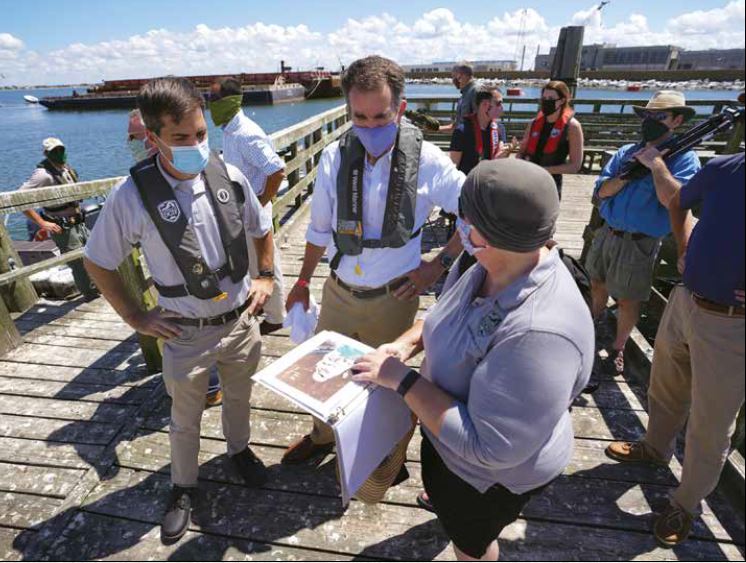
Left to right: DWR Executive Director Ryan Brown, Virginia Governor Ralph Northam, and DWR Assistant Chief of the Wildlife Division Becky Gwynn discuss the plan to create alternative nesting habitat for the shorebirds. Photo by Jack Mayer / Office of Governor Northam
Making Fort Wool Work
Fort Wool, a now-decommissioned Civil War-era military installation, was built in 1819 on Rip Raps Island, adjacent and connected to South Island via a rock revetment. Fortifications and buildings left over from the island’s days as part of the Army’s harbor defense remain on the 15-acre island. The seabirds had historically declined to nest on Fort Wool because of the presence of predators, mature trees and grass-covered parade ground.
In a massive undertaking, DWR staff and contractors worked to not only transform Fort Wool into a suitable nesting site, but to also lease and moor flat-top barges in the embayment between Rip Raps and South islands to create an additional acre of habitat. The effort not only had an extremely tight timeline, but also had to be completed in the midst of the COVID-19 pandemic.
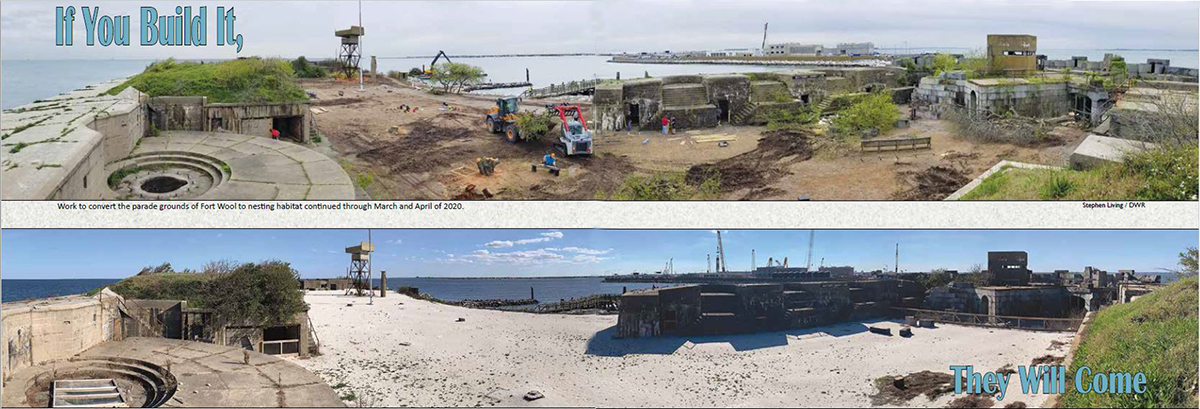
The process of permitting was particularly challenging, as Virginia’s government offices were closed to everyone but essential workers during the early days of the project due to the pandemic-induced shutdown. When working on Rip Raps Island and the barges, DWR staff and contractors had to adhere to social distancing and personal protective equipment requirements.
The work at Fort Wool included converting the parade ground from a tree-lined lawn to a sand flat, the birds’ preferred nesting substrate. Vegetation was removed and DWR contracted with the U.S. Department of Agriculture-Wildlife Services for predator management. Physical barriers were built at doorways, stairwells, and other openings to prevent chicks from entering interior spaces.
All steps were completed following best practices provided by the Virginia Department of Historic Resources, including installing a steel box to protect the grave marker of “Lady,” the dog of one of the personnel serving on Fort Wool during World War II. The American flag that flew at Fort Wool was decom-missioned by a DWR Conservation Police Honor Guard and returned to the Hampton History Museum. By early May, the parade ground was a sandy, safe nesting area. None of the structures or historic setting were altered.
An Acre More on Water
DWR biologists knew that the parade ground at Fort Wool would provide the seabird colony with 1.68 acres of nesting habitat, which was not enough to accommodate even half the birds displaced from South Island where they had roughly 9 acres of ground to nest on. Thus, the idea was born to create another acre of habitat by anchoring flat-top barges in the embayment between Rip Raps Island and South Island. It was a feasible, but not easy, solution.
“We talked to subject-matter experts about alternatives,” said Gwynn. “We’d heard about barges being used by seabirds on the West Coast, but mostly in lakes. And we’re biologists; we didn’t know anything about barges! We did a lot of learning, a lot of meeting with marine contractors, to understand barges.” The permitting process for the barges was complicated by the pandemic restrictions. In addition, having the barges anchored would require planning and mitigation for the storms and hurricanes common during summers on Virginia’s coast.

Part of the newly refurbished Fort Wool including some of the barges placed nearby for additional nesting habitat. Photo by Meghan Marchetti/DWR
DWR worked with engineers to determine the best and safest placement for seven barges that would offer the seabird colony another acre of nesting surface. Barriers were installed around the perimeters of the barges to keep flightless chicks from running off the edges and gravel/sand mix was placed on the topsides to mimic beach habitat. The barges were ready for birds on May 15.
Convincing the Birds
The next challenge was to convince the seabirds to embrace their new nesting sites. DWR biologists worked with VDOT and the HRBT expansion project contractor on a bird management plan that outlined deterrence measures designed to discourage birds from nesting on South Island. DWR biologists also contracted with the Virginia Tech Shorebird Program (VT Team) to entice the birds to Fort Wool and the barges. Colonial seabirds are “group nesters,” so if a handful of birds could be convinced to nest on the newly created habitat, the rest would follow suit.
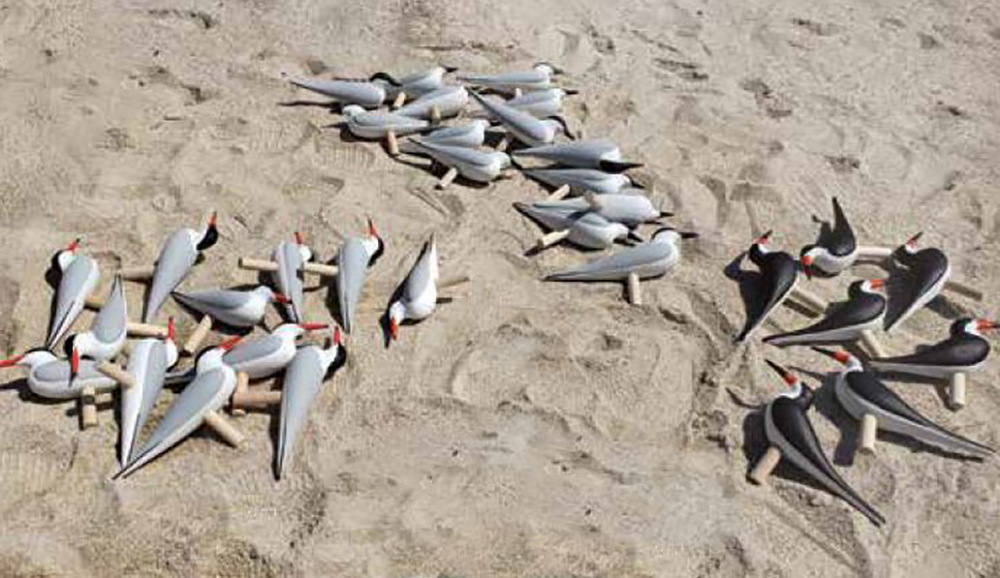
Common tern, gull-billed tern, and black skimmer decoys; ready for placement on the newly created habitat. Photo by Becky Gwynn/DWR
The VT Team set the stage by placing decoys of common terns, royal terns, gull-billed terns, and black skimmers on the parade ground and the barges in an effective pattern to attract the birds. They also set up three sound systems that broadcast a mix of calls of individual species and colony chatter. On South Island, trained dogs worked 24/7 to keep seabirds off the island. Fort Wool was closed to visitors, and a “no boats” zone was established in the waters around Fort Wool and the barges to minimize human disturbance.
Immediately after the habitat at Fort Wool was complete on May 1, seabirds started landing and taking up residence. Royal terns were the first to arrive and they made up the majority of nests on the Fort Wool parade ground. “It was fascinating to see the resources partitioning the birds did,” Gwynn said. “Certain species nested on Fort Wool and others on the barges. There were no royal terns on the barges, and no black skimmers on Fort Wool.”
A Conservation Success
Through May and June, it became clear that the habitat built on Fort Wool and the barges had successfully provided the seabird colony with an alternative nesting site. Approximately 11,000 adult birds took up residence on Fort Wool and roughly 1,000 more on the barges. On July 4, the VT Team and DWR biologists banded more than 2,100 royal tern chicks and 46 sandwich tern chicks on Fort Wool alone. Uniquely coded white plastic field readable bands were applied on royal tern, common tern, gull-billed tern, black skimmer, and laughing gull chicks. By the time the seabird colony departed Fort Wool for its wintering grounds further south, the VT Team and DWR biologists estimate that as many as 6,000 chicks had hatched.

Terns congregate at their new home on Fort Wool. Photo by Meagan Thomas/DWR
During the summer, the birds at Fort Wool and on the barges weathered at least three major storm events, including Tropical Storm Isaias. DWR closely monitored the effects of the storms on the birds. “We spent all year thinking of this whole effort as an adaptive management challenge,” said Gwynn. “We learned a lot that we applied as the summer went on and that we’ll apply next year.”
The barges left the Fort Wool embayment in mid-September. DWR plans to re-install them in time for the 2021 seabird nesting season, while long-term plans include the possible construction of a seabird nesting island somewhere in the lower James River or Chesapeake Bay.
The successful conversion of Fort Wool from a former military installation to suitable seabird breeding habitat and the creation of an additional acre of habitat on the barges in a matter of a few months was a massive undertaking and a milestone in habitat conservation. “The birds’ responses to the work that we did was incredible,” Gwynn said. “For example, twice as many royal tern chicks survived to fledging on Fort Wool than had the previous year on South Island. We can attribute that to great habitat, few predators, no people, and an outstanding food supply. We have learned so much during this first nesting season that we think will make 2021 and beyond even more successful for the birds.”

This article originally appeared in Virginia Wildlife Magazine.
For more information-packed articles and award-winning images, subscribe today!
Learn More & Subscribe




